Enhancing the Mechanical and Electrical Properties of Poly(Vinyl Chloride)-Based Conductive Nanocomposites by Zinc Oxide Nanorods
Abstract
1. Introduction
2. Experimental
2.1. Materials
2.2. Synthesis of MWCNT–ZnO–RGO Hybrid Particles
2.3. Preparation of PVC/MWCNT–ZnO–RGO Nanocomposites
2.4. Characterization
3. Results and Discussion
3.1. Characterization of the Nanoparticles
3.2. Interfacial Interaction in the PVC/MWCNT–ZnO–RGO Nanocomposites
4. Conclusions
Author Contributions
Funding
Conflicts of Interest
References
- Madaleno, L.; Schjødt-Thomsen, J.; Pinto, J.C. Morphology, thermal and mechanical properties of PVC/MMT nanocomposites prepared by solution blending and solution blending+ melt compounding. Compos. Sci. Technol. 2010, 70, 804–814. [Google Scholar] [CrossRef]
- Ebnalwaled, A.; Thabet, A. Controlling the optical constants of PVC nanocomposite films for optoelectronic applications. Synth. Met. 2016, 220, 374–383. [Google Scholar] [CrossRef]
- Mallakpour, S.; Madani, M. Effect of functionalized TiO2 on mechanical, thermal and swelling properties of chitosan-based nanocomposite films. Polym. Plast. Technol. Eng. 2015, 54, 1035–1042. [Google Scholar] [CrossRef]
- Owen, J. Degradation and Stabilisation of PVC; Springer Science & Business Media: Berlin, Germany, 2012. [Google Scholar]
- Rabek, J.F. Polymer Photodegradation: Mechanisms and Experimental Methods; Springer Science & Business Media: Berlin, Germany, 2012. [Google Scholar]
- William Coaker, A. Fire and flame retardants for PVC. J. Vinyl Addit. Technol. 2003, 9, 108–115. [Google Scholar] [CrossRef]
- Ghaemy, M.; Nasab, S.A. Synthesis and identification of organosoluble polyamides bearing a triaryl imidazole pendent: Thermal, photophysical, chemiluminescent, and electrochemical characterization with a modified carbon nanotube electrode. React. Funct. Polym. 2010, 70, 306–313. [Google Scholar] [CrossRef]
- Wu, G.-H.; Liu, S.-Q.; Wu, X.-Y.; Ding, X.-M. Influence of MWCNTs modified by silane coupling agent KH570 on the properties and structure of MWCNTs/PLA composite film. J. Polym. Res. 2016, 23, 155. [Google Scholar] [CrossRef]
- Li, J.; Wu, Z.; Huang, C.; Liu, H.; Huang, R.; Li, L. Mechanical properties of cyanate ester/epoxy nanocomposites modified with plasma functionalized MWCNTs. Compos. Sci. Technol. 2014, 90, 166–173. [Google Scholar] [CrossRef]
- Karousis, N.; Tagmatarchis, N.; Tasis, D. Current progress on the chemical modification of carbon nanotubes. Chem. Rev. 2010, 110, 5366–5397. [Google Scholar] [CrossRef] [PubMed]
- Altintas, O.; Riazi, K.; Lee, R.; Lin, C.Y.; Coote, M.L.; Wilhelm, M.; Barner-Kowollik, C. RAFT-based polystyrene and polyacrylate melts under thermal and mechanical stress. Macromolecules 2013, 46, 8079–8091. [Google Scholar] [CrossRef]
- Mallakpour, S.; Abdolmaleki, A.; Azimi, F. Ultrasonic-assisted biosurface modification of multi-walled carbon nanotubes with Thiamine and its influence on the properties of PVC/Tm-MWCNTs nanocomposite films. Ultrason. Sonochem. 2017, 39, 589–596. [Google Scholar] [CrossRef] [PubMed]
- Mkhabela, V.J.; Mishra, A.K.; Mbianda, X.Y. Thermal and mechanical properties of phosphorylated multiwalled carbon nanotube/polyvinyl chloride composites. Carbon 2011, 49, 610–617. [Google Scholar] [CrossRef]
- Broza, G.; Piszczek, K.; Schulte, K.; Sterzynski, T. Nanocomposites of poly(vinyl chloride) with carbon nanotubes (CNT). Compos. Sci. Technol. 2007, 67, 890–894. [Google Scholar] [CrossRef]
- Mamunya, Y.; Boudenne, A.; Lebovka, N.; Ibos, L.; Candau, Y.; Lisunova, M. Electrical and thermophysical behaviour of PVC-MWCNT nanocomposites. Compos. Sci. Technol. 2008, 68, 1981–1988. [Google Scholar] [CrossRef]
- Wimalasiri, Y.; Zou, L. Carbon nanotube/graphene composite for enhanced capacitive deionization performance. Carbon 2013, 59, 464–471. [Google Scholar] [CrossRef]
- Hu, H.; Zhao, L.; Liu, J.; Liu, Y.; Cheng, J.; Luo, J.; Liang, Y.; Tao, Y.; Wang, X.; Zhao, J. Enhanced dispersion of carbon nanotube in silicone rubber assisted by graphene. Polymer 2012, 53, 3378–3385. [Google Scholar] [CrossRef]
- Song, P.A.; Liu, L.; Fu, S.; Yu, Y.; Jin, C.; Wu, Q.; Zhang, Y.; Li, Q. Striking multiple synergies created by combining reduced graphene oxides and carbon nanotubes for polymer nanocomposites. Nanotechnology 2013, 24, 125704. [Google Scholar] [CrossRef] [PubMed]
- Bilalis, P.; Katsigiannopoulos, D.; Avgeropoulos, A.; Sakellariou, G. Non-covalent functionalization of carbon nanotubes with polymers. RSC Adv. 2014, 4, 2911–2934. [Google Scholar] [CrossRef]
- Gupta, J.; Wan, C.; Haddleton, D.M.; McNally, T. Plasticisation and compatibilisation of poly (propylene) with poly (lauryl acrylate) surface modified MWCNTs. Polymer 2017, 133, 89–101. [Google Scholar] [CrossRef]
- Gupta, J.; Keddie, D.J.; Wan, C.; Haddleton, D.M.; McNally, T. Functionalisation of MWCNTs with poly (lauryl acrylate) polymerised by Cu (0)-mediated and RAFT methods. Polym. Chem. 2016, 7, 3884–3896. [Google Scholar] [CrossRef]
- Zhou, J.; Lubineau, G. Improving electrical conductivity in polycarbonate nanocomposites using highly conductive PEDOT/PSS coated MWCNTs. ACS Appl. Mater. Interface 2013, 5, 6189–6200. [Google Scholar] [CrossRef] [PubMed]
- Zhou, J.; Aguilar Ventura, I.; Lubineau, G. Probing the role of poly (3, 4-ethylenedioxythiophene)/poly (styrenesulfonate)-coated multiwalled carbon nanotubes in the thermal and mechanical properties of polycarbonate nanocomposites. Ind. Eng. Chem. Res. 2014, 53, 3539–3549. [Google Scholar] [CrossRef]
- Ventura, I.A.; Zhou, J.; Lubineau, G. Drastic modification of the piezoresistive behavior of polymer nanocomposites by using conductive polymer coatings. Compos. Sci. Technol. 2015, 117, 342–350. [Google Scholar] [CrossRef]
- Ventura, I.A.; Zhou, J.; Lubineau, G. Investigating the inter-tube conduction mechanism in polycarbonate nanocomposites prepared with conductive polymer-coated carbon nanotubes. Nanoscale Res. Lett. 2015, 10, 485. [Google Scholar] [CrossRef] [PubMed]
- Zhu, J.; Zeng, G.; Nie, F.; Xu, X.; Chen, S.; Han, Q.; Wang, X. Decorating graphene oxide with CuO nanoparticles in a water–isopropanol system. Nanoscale 2010, 2, 988–994. [Google Scholar] [CrossRef] [PubMed]
- Pendashteh, A.; Mousavi, M.F.; Rahmanifar, M.S. Fabrication of anchored copper oxide nanoparticles on graphene oxide nanosheets via an electrostatic coprecipitation and its application as supercapacitor. Electrochim. Acta 2013, 88, 347–357. [Google Scholar] [CrossRef]
- Nasiri, N.; Bo, R.; Wang, F.; Fu, L.; Tricoli, A. Ultraporous Electron-Depleted ZnO Nanoparticle Networks for Highly Sensitive Portable Visible-Blind UV Photodetectors. Adv. Mater. 2015, 27, 4336–4343. [Google Scholar] [CrossRef] [PubMed]
- Zhang, X.-L.; Zhao, X.; Liu, Z.-B.; Shi, S.; Zhou, W.-Y.; Tian, J.-G.; Xu, Y.-F.; Chen, Y.-S. Nonlinear optical and optical limiting properties of graphene oxide–Fe3O4 hybrid material. J. Optic. 2011, 13, 075202. [Google Scholar] [CrossRef]
- Xie, G.; Xi, P.; Liu, H.; Chen, F.; Huang, L.; Shi, Y.; Hou, F.; Zeng, Z.; Shao, C.; Wang, J. A facile chemical method to produce superparamagnetic graphene oxide–Fe3O4 hybrid composite and its application in the removal of dyes from aqueous solution. J. Mater. Chem. 2012, 22, 1033–1039. [Google Scholar] [CrossRef]
- Kim, Y.; Lee, J.-H.; Cho, S.; Kwon, Y.; In, I.; Lee, J.; You, N.-H.; Reichmanis, E.; Ko, H.; Lee, K.-T. Additive-free hollow-structured Co3O4 nanoparticle Li-ion battery: The origins of irreversible capacity loss. ACS Nano 2014, 8, 6701–6712. [Google Scholar] [CrossRef] [PubMed]
- Olad, A.; Nosrati, R. Preparation and corrosion resistance of nanostructured PVC/ZnO–polyaniline hybrid coating. Prog. Organic Coat. 2013, 76, 113–118. [Google Scholar] [CrossRef]
- Elashmawi, I.; Hakeem, N.; Marei, L.; Hanna, F. Structure and performance of ZnO/PVC nanocomposites. Phys. B Conden. Matter 2010, 405, 4163–4169. [Google Scholar] [CrossRef]
- Šupová, M.; Martynková, G.S.; Barabaszová, K. Effect of nanofillers dispersion in polymer matrices: A review. Sci. Adv. Mater. 2011, 3, 1–25. [Google Scholar] [CrossRef]
- Chen, J.; Yao, B.; Li, C.; Shi, G. An improved Hummers method for eco-friendly synthesis of graphene oxide. Carbon 2013, 64, 225–229. [Google Scholar] [CrossRef]
- Uekawa, N.; Yamashita, R.; Wu, Y.J.; Kakegawa, K. Effect of alkali metal hydroxide on formation processes of zinc oxide crystallites from aqueous solutions containing Zn (OH)42− ions. Phys. Chem. Chem. Phys. 2004, 6, 442–446. [Google Scholar] [CrossRef]
- Yan, J.; Feng, L.; Zhong, R.W. Catalytic growth of carbon nanotubes with large inner diameters. J. Serb. Chem. Soc. 2005, 70, 277–282. [Google Scholar] [CrossRef]
- Cai, D.; Song, M. Preparation of fully exfoliated graphite oxide nanoplatelets in organic solvents. J. Mater. Chem. 2007, 17, 3678–3680. [Google Scholar] [CrossRef]
- Li, P.; Chen, X.; Zeng, J.-B.; Gan, L.; Wang, M. Enhancement of the interfacial interaction between poly (vinyl chloride) and zinc oxide modified reduced graphene oxide. RSC Adv. 2016, 6, 5784–5791. [Google Scholar] [CrossRef]
- Li, P.; Li, J.; Zhao, Z.; Fang, Z.; Yang, M.; Yuan, Z.; Zhang, Y.; Zhang, Q.; Hong, W.; Chen, X. A General Electrode Design Strategy for Flexible Fiber Micro-Pseudocapacitors Combining Ultrahigh Energy and Power Delivery. Adv. Sci. 2017, 4, 1700003. [Google Scholar] [CrossRef] [PubMed]
- Harkins, W.D. The Physical Chemistry of Surface Films; Reinhold: New York, NY, USA, 1952. [Google Scholar]
- Fenouillot, F.; Cassagnau, P.; Majesté, J.-C. Uneven distribution of nanoparticles in immiscible fluids: Morphology development in polymer blends. Polymer 2009, 50, 1333–1350. [Google Scholar] [CrossRef]
- Zhang, S.; Deng, H.; Zhang, Q.; Fu, Q. Formation of conductive networks with both segregated and double-percolated characteristic in conductive polymer composites with balanced properties. ACS Appl. Mater. Interface 2014, 6, 6835–6844. [Google Scholar] [CrossRef] [PubMed]
- Voyiatzis, G.; Andrikopoulos, K.; Papatheodorou, G.; Kamitsos, E.; Chryssikos, G.D.; Kapoutsis, J.; Anastasiadis, S.; Fytas, G. Polarized resonance Raman and FTIR reflectance spectroscopic investigation of the molecular orientation in industrial poly (vinyl chloride) specimens. Macromolecules 2000, 33, 5613–5623. [Google Scholar] [CrossRef]
- McNally, T.; Pötschke, P.; Halley, P.; Murphy, M.; Martin, D.; Bell, S.E.; Brennan, G.P.; Bein, D.; Lemoine, P.; Quinn, J.P. Polyethylene multiwalled carbon nanotube composites. Polymer 2005, 46, 8222–8232. [Google Scholar] [CrossRef]
- Xie, X.-L.; Liu, Q.-X.; Li, R.K.-Y.; Zhou, X.-P.; Zhang, Q.-X.; Yu, Z.-Z.; Mai, Y.-W. Rheological and mechanical properties of PVC/CaCO3 nanocomposites prepared by in situ polymerization. Polymer 2004, 45, 6665–6673. [Google Scholar] [CrossRef]
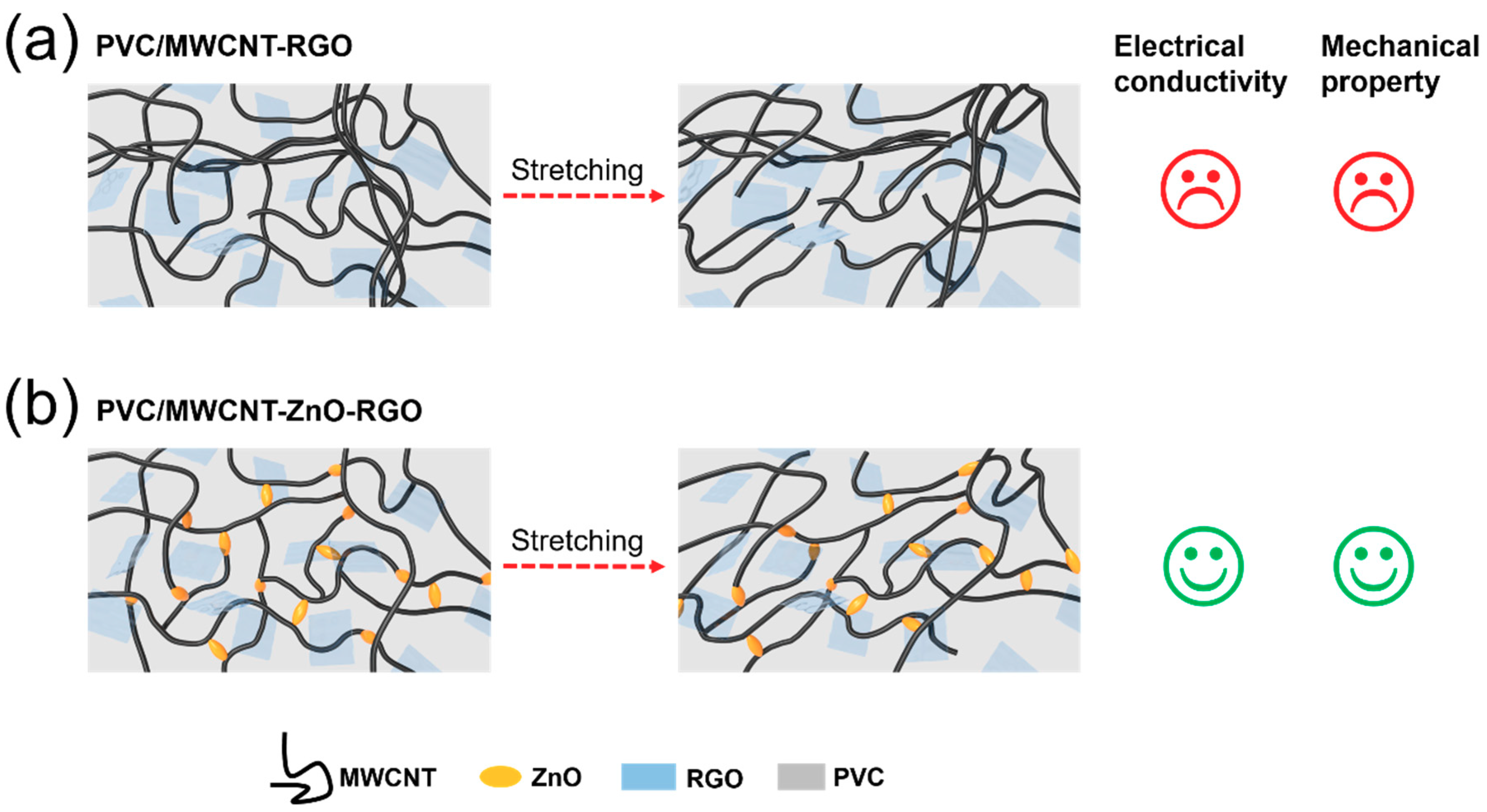

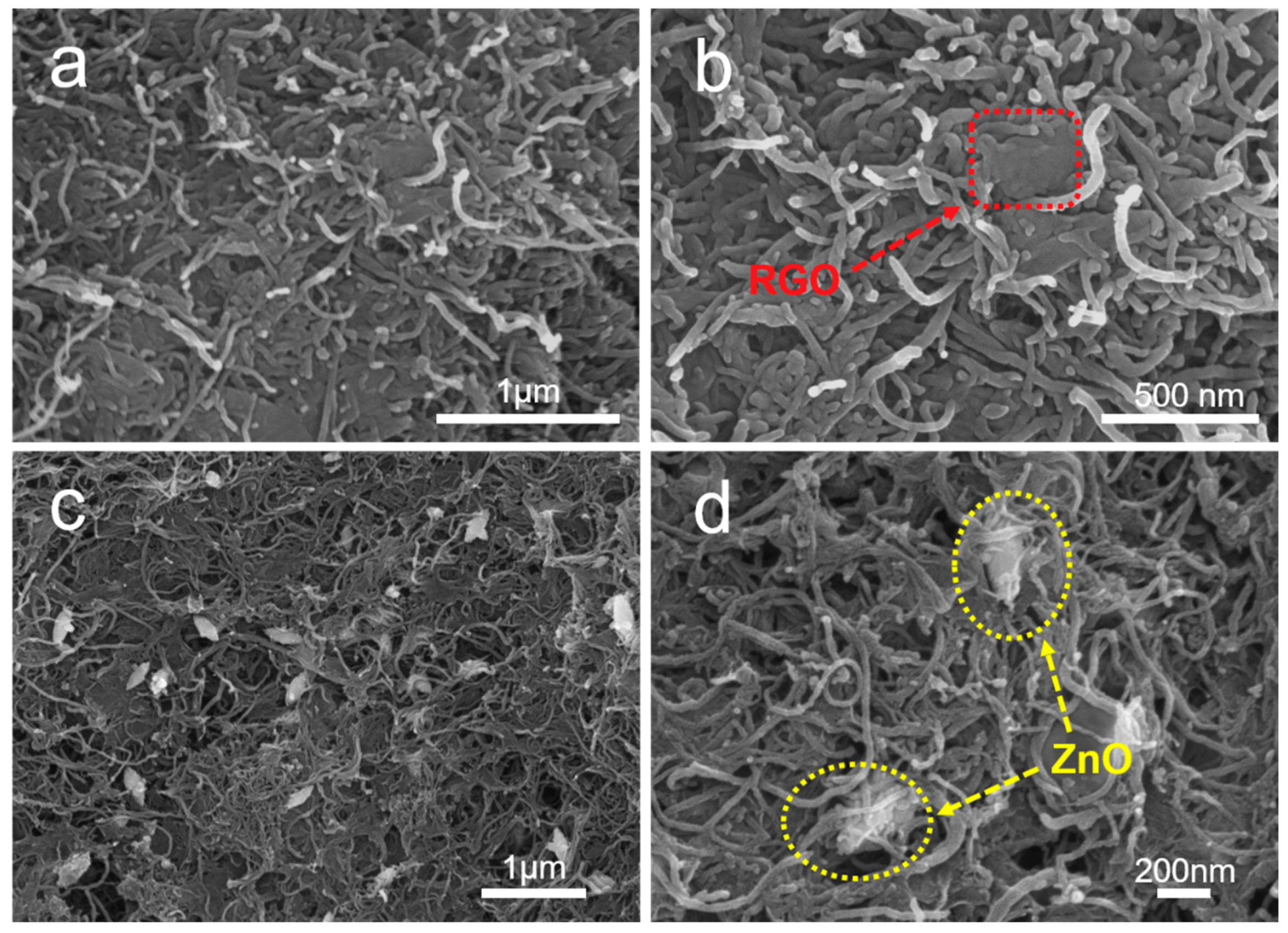

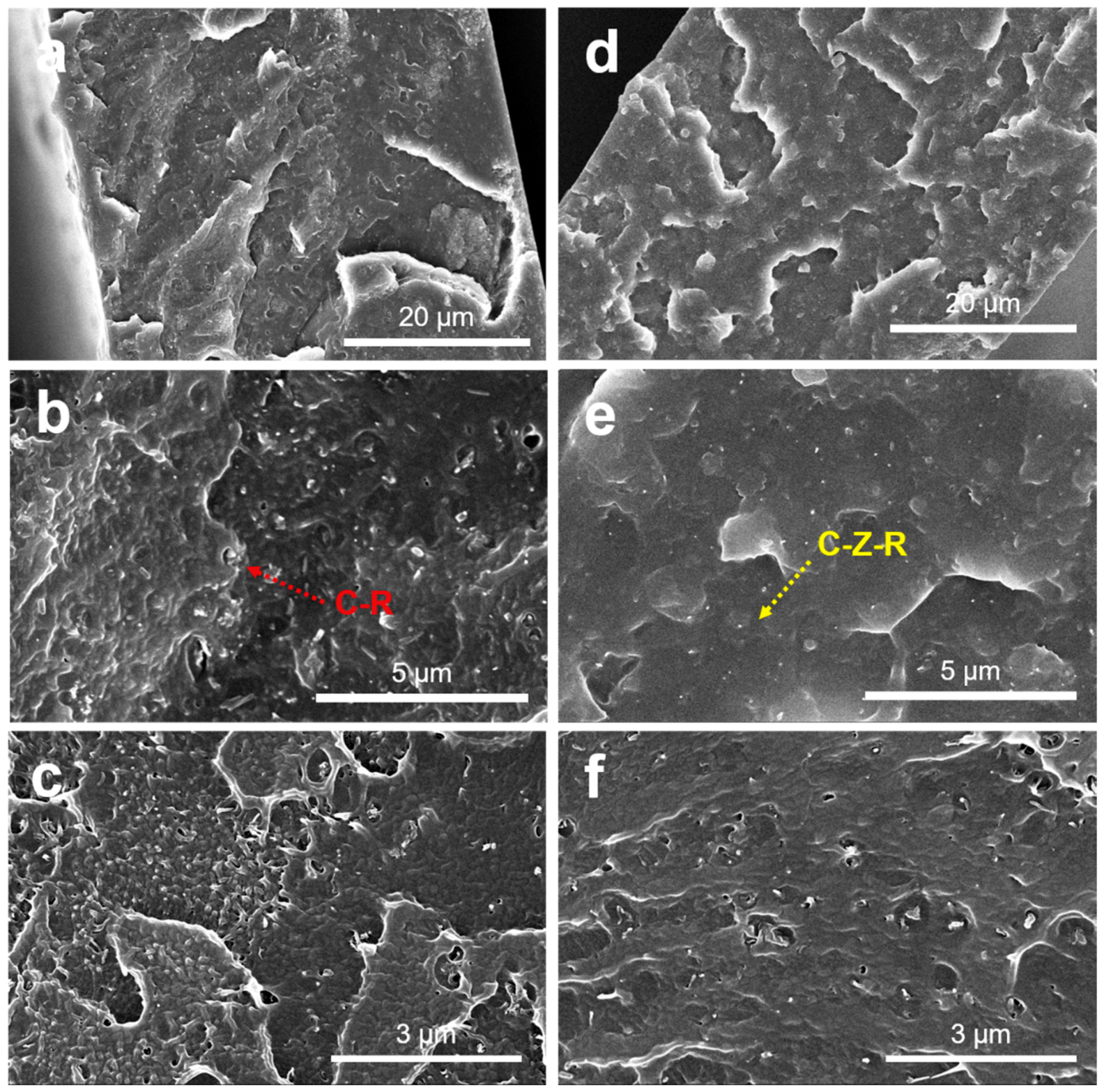

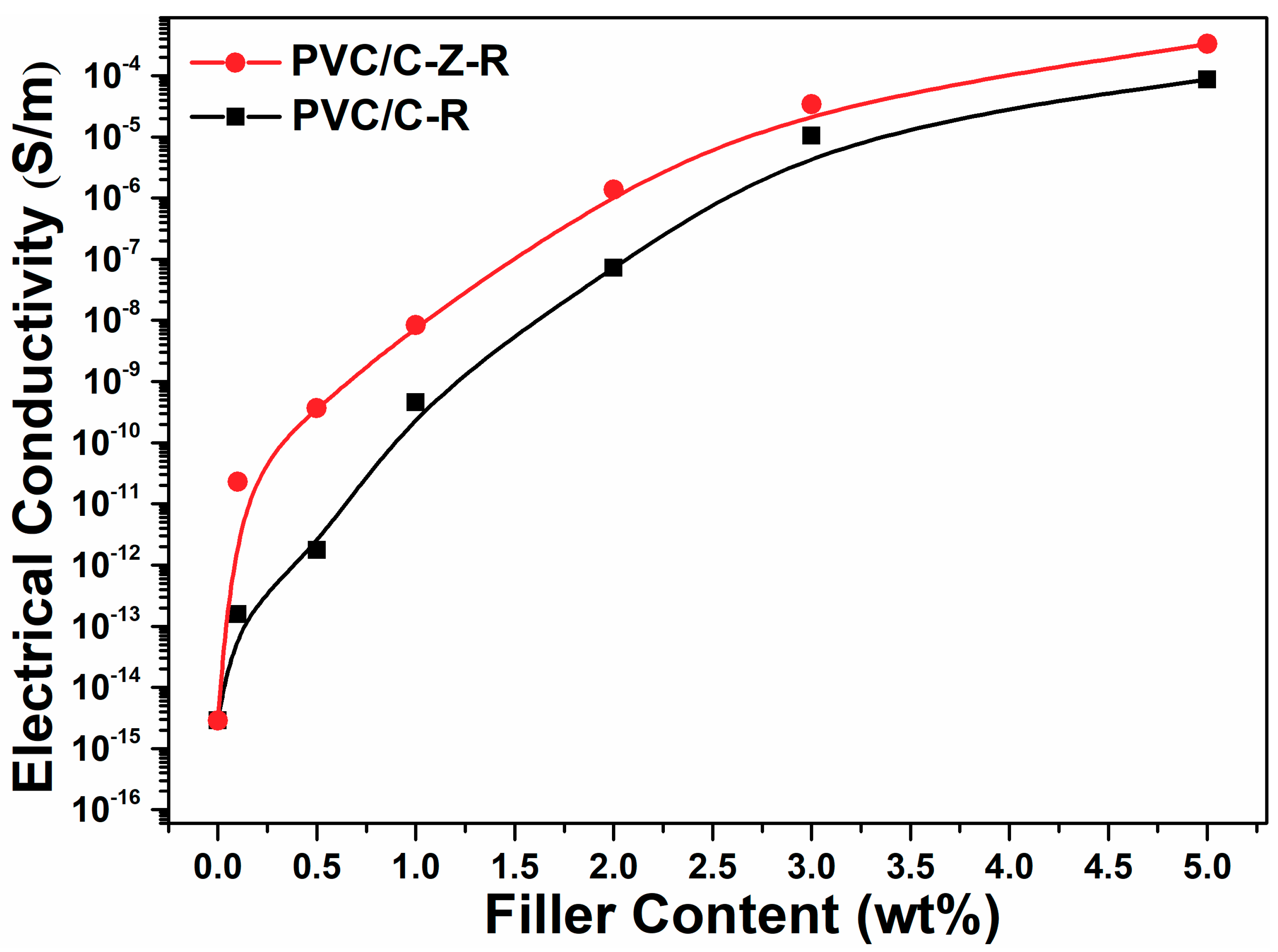
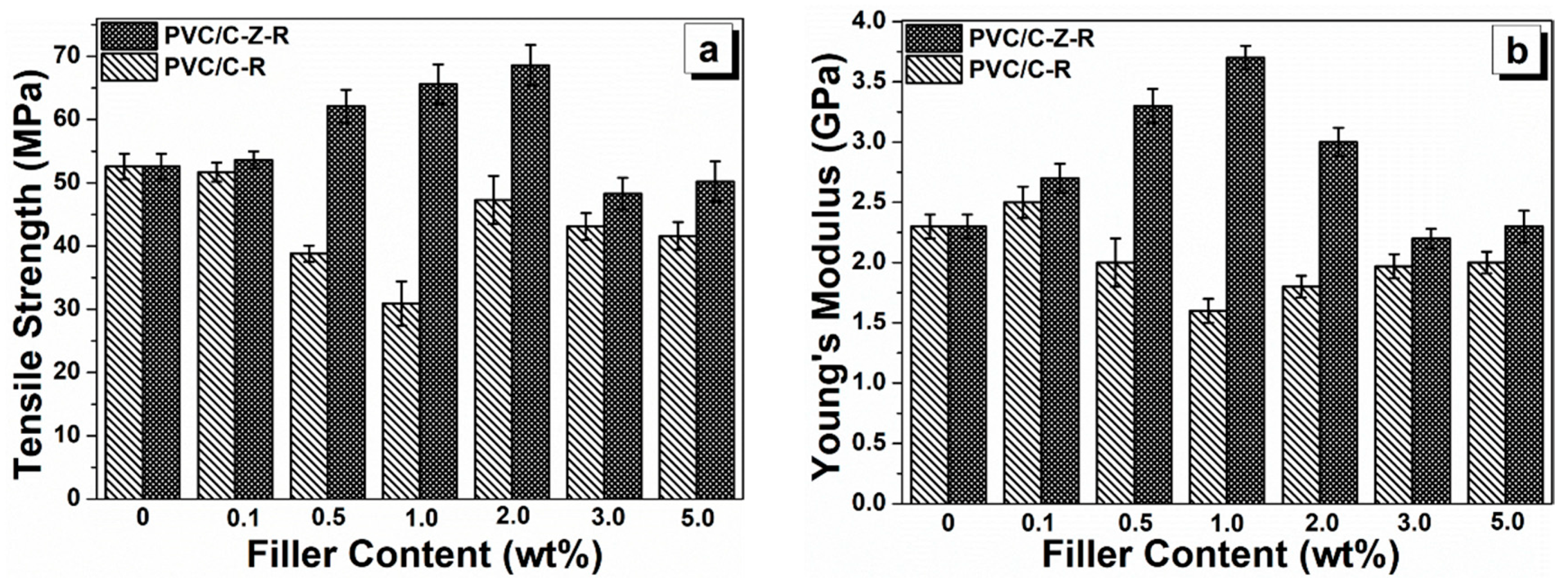

| Samples | Percentage of Filler Loading in PVC (wt.%) | Abbreviation |
|---|---|---|
| PVC | 0 | PVC |
| MWCNT–RGO | 0 | C–R |
| MWCNT–ZnO–RGO | 0 | C–Z–R |
| PVC/0.1 wt.% MWCNT–RGO | MWCNT–RGO = 0.1 wt.% | PVC/0.1 wt.% C–R |
| PVC/0.2 wt.% MWCNT–RGO | MWCNT–RGO = 0.2 wt.% | PVC/0.2 wt.% C–R |
| PVC/0.5 wt.% MWCNT–RGO | MWCNT–RGO = 0.5 wt.% | PVC/0.5 wt.% C–R |
| PVC/1.0 wt.% MWCNT–RGO | MWCNT–RGO = 1.0 wt.% | PVC/1.0 wt.% C–R |
| PVC/2.0 wt.% MWCNT–RGO | MWCNT–RGO = 2.0 wt.% | PVC/2.0 wt.% C–R |
| PVC/3.0 wt.% MWCNT–RGO | MWCNT–RGO = 3.0 wt.% | PVC/3.0 wt.% C–R |
| PVC/5.0 wt.% MWCNT–RGO | MWCNT–RGO = 5.0 wt.% | PVC/5.0 wt.% C–R |
| PVC/0.1 wt.% MWCNT–ZnO–RGO | MWCNT–ZnO–RGO = 0.1 wt.% | PVC/0.1 wt.% C–Z–R |
| PVC/0.2 wt.% MWCNT–ZnO–RGO | MWCNT–ZnO–RGO = 0.2 wt.% | PVC/0.2 wt.% C–Z–R |
| PVC/0.5 wt.% MWCNT–ZnO–RGO | MWCNT–ZnO–RGO = 0.5 wt.% | PVC/0.5 wt.% C–Z–R |
| PVC/1.0 wt.% MWCNT–ZnO–RGO | MWCNT–ZnO–RGO = 1.0 wt.% | PVC/1.0 wt.% C–Z–R |
| PVC/2.0 wt.% MWCNT–ZnO–RGO | MWCNT–ZnO–RGO = 2.0 wt.% | PVC/2.0 wt.% C–Z–R |
| PVC/3.0 wt.% MWCNT–ZnO–RGO | MWCNT–ZnO–RGO = 3.0 wt.% | PVC/3.0 wt.% C–Z–R |
| PVC/5.0 wt.% MWCNT–ZnO–RGO | MWCNT–ZnO–RGO = 5.0 wt.% | PVC/5.0 wt.% C–Z–R |
| Samples | Surface Tension (mN/m) | Interfacial Energies with PVC (mN/m) | Spreading Coefficient with PVC (mN/m) | ||||
|---|---|---|---|---|---|---|---|
| Total | Dispersive | Polar Part | Harmonic | Geometric | Harmonic | Geometric | |
| PVC | 43.2 | 42.0 | 1.2 | ||||
| MWCNT–RGO | 71.2 | 69.04 | 2.16 | 6.86 | 50.76 | −34.86 | −78.75 |
| MWCNT–ZnO–RGO | 25.72 | 25.5 | 0.22 | 4.74 | 2.45 | 12.74 | 15.03 |
© 2018 by the authors. Licensee MDPI, Basel, Switzerland. This article is an open access article distributed under the terms and conditions of the Creative Commons Attribution (CC BY) license (http://creativecommons.org/licenses/by/4.0/).
Share and Cite
Qiu, F.; He, G.; Hao, M.; Zhang, G. Enhancing the Mechanical and Electrical Properties of Poly(Vinyl Chloride)-Based Conductive Nanocomposites by Zinc Oxide Nanorods. Materials 2018, 11, 2139. https://doi.org/10.3390/ma11112139
Qiu F, He G, Hao M, Zhang G. Enhancing the Mechanical and Electrical Properties of Poly(Vinyl Chloride)-Based Conductive Nanocomposites by Zinc Oxide Nanorods. Materials. 2018; 11(11):2139. https://doi.org/10.3390/ma11112139
Chicago/Turabian StyleQiu, Feng, Guangjian He, Mingyang Hao, and Guizhen Zhang. 2018. "Enhancing the Mechanical and Electrical Properties of Poly(Vinyl Chloride)-Based Conductive Nanocomposites by Zinc Oxide Nanorods" Materials 11, no. 11: 2139. https://doi.org/10.3390/ma11112139
APA StyleQiu, F., He, G., Hao, M., & Zhang, G. (2018). Enhancing the Mechanical and Electrical Properties of Poly(Vinyl Chloride)-Based Conductive Nanocomposites by Zinc Oxide Nanorods. Materials, 11(11), 2139. https://doi.org/10.3390/ma11112139




